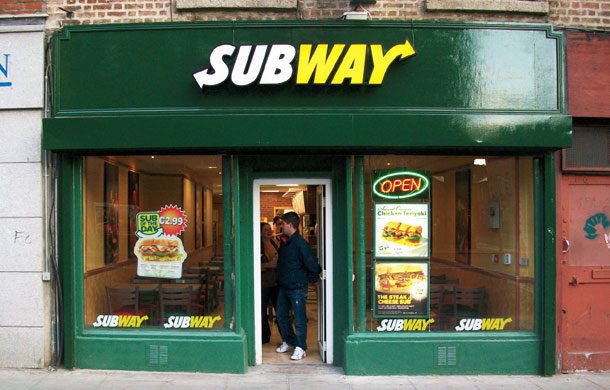What makes Subway such a Great Franchise?

The Subway Franchise has expanded almost what seems to be effortlessly over the past twenty years to become the world’s largest restaurant chain with over 44,000 locations around the world (www.subway.com/subwayroot/ExploreOurWorld.aspx). The brand has become known as a consistent leader in the franchise community being ranked on the Entrepreneur Franchise 500 in the top five global franchise systems every year. So what is behind this model that has taken it to such heights when compared with other franchise brands?
First, there is some luck involved. Starbucks rode the wave of the specialty coffee retail market segment which expanded with tremendous growth, almost doubling coffee consumption from 1995 to 2014. The sub sandwich market also experienced growth similar to this since the 1990’s and today 50% of Americans have a sandwich literally every day (http://www.smithsonianmag.com/smart-news/each-day-50-percent-america-eats-sandwich-180952972/?no-ist). So Subway certainly benefited from this growing sandwich trend and part of the company’s rise to power must be attributed to the growth in the market they were in and the timing they had when the brand was launched. Subway started franchising in 1974 and was able to achieve 3000 units by 1990 allowing them to leverage a successful brand when the sub sandwich market grew substantially.
Second, the franchise market is based on a business’ ability to replicate itself, irrespective of operator, market or staff. Subway has certainly mastered this art and taken the concept of streamlined business operations to an entirely new definition. Nothing about a Subway is unique from one location to the next, the signage, décor floor layout, array of toppings, equipment and uniforms. Everything looks the same, feels the same and tastes the same whether you are eating in a downtown metropolitan location or a non-traditional subway inside a gas station. The consumer knows what to expect, the vendors know what to expect, the franchisor knows what to expect and in the end the franchisee knows what to expect….so they keep investing in more units. Successful Subway franchisees own 20 or more units in many cases. Training processes are structured, defined, backed up by solid documentation and good process-driven technology. The POS systems provide value-oriented data, are easy to use and make enterprise data readily available for virtual support from the franchisor.
Third, the Subway model has succeeded due to it’s ability to operate in close proximity to one another. Now, if you ask any franchisee, they rightfully so will tell you that the units are too close and they are cannibalizing one another’s business. But the truth is that the sandwich market is big, growing and hyper competitive, if a Subway franchise isn’t placed in a location, odds are that a competitor will be. The Franchisor’s argument here is that although sales may drop with the addition of new franchises in the same market, competition would have affected store sales even further. By having locations in the same markets, there are advertising, branding and cooperative ad strategies that benefit all of the franchisees. Good locations are locked in and keep competition out providing the ability to saturate a market and really offer an advantage when compared to more spread out franchise systems.
Fourth, Subway’s brand, product line and offering has mass market appeal. Some of the fastest growing markets for Subway have been international growth including the Middle East, China, South America and other regions. The brand has the ability to fit into most cultures, populations, ethnicities and demographics….it seems to work almost anywhere. The concept is designed specifically for today’s largest spending population – Millennials – who want things fast, quick and easy. The value proposition is strong with a decent tasting product for a very reasonable price point – $5 subs, etc. All of these combine to make for a strong consumer offering and a sandwich business that has a good chance for success in just about any strip center.
As a franchisor, what can you do to imitate Subway’s success? Develop a strong operating model that provides franchisees with good systems, structure and operating platforms. Have a strong training program with a support model that delivers value, content and substance to franchisees as they open their business. Create an R&D plan/budget to come up with new products and services to keep franchisees satisfied with their investment in the business. Offer strategic value to your franchisees, real estate, technology, marketing, branding and other initiatives require an ongoing commitment and investment of time and money from the franchisor. Never stop marketing the franchise, the business, the product and the brand.
Christopher Conner
Franchise Marketing Systems
For more information on how to franchise your business, Contact Franchise Marketing Systems:
